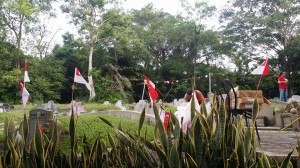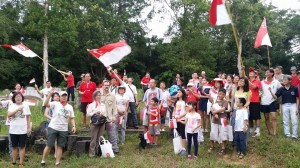Reflections after a Guided Walk@Bukit Brown
1By Zhang Jiayi
In the early afternoon last Sunday (2 August, 2015) I dreaded my decision to go for a guided walk around Bukit Brown cemetery. However, I have promised my friends that I will turn up, so grudgingly, I made my way to the meeting point for the walking tour. Three hours and a lot of mosquito bites later, it is a decision that I did not regret.
Tombstones don’t lie. All aspects of the tombs – from the layout, the materials used, the carvings and statues around the tomb – give us snippets of information about the individuals and the Chinese immigrant community in early Singapore. The tour shed light on the stories of the individuals; after the tour, the occupants of Bukit Brown turned from random people to dignified individuals who made a difference to the social reality we experience today. Our history and social studies curriculum doesn’t do justice to the various individuals who made a difference to Singapore. While we know a significant bit about Tan Tock Seng, we overlooked the contributions of his eldest son, Tan Kim Ching, who is also buried in Bukit Brown. Tan Kim Ching not only participated actively in philanthropy, just like how Tan Tock Seng did, he also had a close relationship with the royal family of Siam (known as Thailand now), and played an important role in diplomatic relations between the Straits Settlements and Siam. It is also to my surprise that the 72nd generation of Confucius also set foot in Singapore, and is also buried in Bukit Brown cemetery *.
The diversity of the ‘residents’ of Bukit Brown was jaw dropping. Tombs of Hokkiens, Teochews, Cantonese, men, women, the rich and the poor can be found in Bukit Brown cemetery. A range of calendars was used in the inscriptions of headstones in documenting the time of birth and death of individuals. Some Chinese pledged allegiance to the Ming dynasty of China and at their time of death dreaded the fact that they would be buried in a foreign land, while others were content to call Singapore home and to be buried here. I saw for myself the intricate Peranakan tiles laying some of the tombs of wealthy Peranakan Chinese, who chose to be buried in Bukit Brown as they did not identify with their Chinese dialect clans. It was also fascinating to gain an insight on how the early Chinese viewed death – many of them viewed their tombs as their homes in afterlife, and the layout of the tombs resembled the layout of homes. Much thought was put into the building of tombs; some tombs had carvings transmitting values like filial piety, some had intricate statues symbolizing prosperity, fertility and abundance, while other had inscriptions revealing how they felt when they were buried in Singapore. The trip was especially meaningful for me, as a female.
I learned more about the contributions of early Chinese women to the cause of gender equality we have today. Ms Lee Choo Neo, the founder of a Chinese Ladies Association, lobbied for the right of females to live a more enriching life. The Association taught domestic skills, supported education for females, and sponsored a rescue home for women. She was in her teens when she started these big projects. She can be rightfully known as, according to my understanding, the grandmother of the civil society in Singapore. The experience exposed how much I didn’t know about the history of Singapore, beyond what was taught in our social studies and history textbooks. I was deeply humbled by the number of times I widened my eyes in surprise as the volunteer guides (Brownies) dropped nuggets of trivia about prominent early Chinese immigrants. There is just so much the cemetery revealed about who we are as Singaporeans before Singapore’s independence, and the place unjustified the sweeping claims about how Singapore is ‘cultureless’.
As we celebrate 50 years of Singapore’s independence, let us remember, as the guides rightly pointed out, that it is also our 70th year of liberation from the Japanese Occupation, and almost a century from the time we were first part of the Straits Settlements. It is my hope that the stories told during the tour are documented and made available to a wider audience, lest our social history be like those resting in Bukit Brown cemetery – buried six feet underground, never to be seen or heard by the future generations of Singaporeans.
*Editors Clarification: The 72nd direct descendant of Confucius had prepared his grave with the intention of being buried beside this wife who passed away before him, but he was buried at Bidadari instead. We thank Jiayi for taking time to pen her thoughts on her first visit to Bukit Brown and invite anyone who would like to contribute a blog post to write to a.t.bukitbrown@gmail.com. For information on guided walks please visit bukitbrown.com for weekly updates.
About Jiayi: Jiayi is a young Singaporean still in search of what makes her Singaporean. She is interested in issues relating to the Singaporean society as a whole, including social stratification, education and national identity.
*********************************************************



Re Tan Kim Ching, son of Tan Tock Seng: He not only played a key role between Siam and the Straits Settlements, but a hugely important part in the Larut Wars that ended with the Treaty of Pankor thereby settling the contending parties for control of the Perak mines. Tan Kim Ching’s fortunes were made with his rice mills in Siam–the first to use modern machines brought in from Scotland. He had rice concessions in several countries being perhaps one of the earliest CEOS of a multi-nationational enterprise that stretched from Indonesia, Malaya, Siam and Vietnam. In addition to being Consul for Siam, he was also Consul for Japan and Russia and a Justice of the Peace. For his philanthropic donations to various relief efforts in China he was awarded the second Civll Mandarinate rank of the Golden Pheasant. He is popularly remembered through his connections with the Siamese court for his role in securing Anna Leonowens her position as teacher to the royal children.